
A TV's circuits have hundreds of electronic components, including transistors, resistors and capacitors. A capacitor acts as a reservoir for electric charge, storing and releasing electricity in precise amounts. A TV has dozens of kinds of capacitors, used as couplers between circuits, as timing components and as electronic filters.
Capacitor
Video of the Day
A capacitor is a simple device consisting of a pair of metal foils separated by a thin insulator, such as plastic. A wire bonded to each foil carries electric charges to it. When you connect a capacitor's wires to a current source such as a battery, charges flow into the foils. When the foils are full of charge, the current stops flowing. If you then connect the capacitor to an electrical load such as a resistor or transistor, charges flow back out of the foils until they become empty. Capacitors come in a wide variety of capacitances, measured in farads. Capacitors having a small capacitance fill up quickly; large capacitors take longer to fill.
Video of the Day
Power Supply
Most televisions have a power supply that converts the 110-volt alternating current from a household outlet to a low-voltage direct current. Power supply circuits use large capacitors as a sort of electronic "muffler" that removes electrical noise from the DC. Because capacitors hold electric charge, they act as dampers, slowing down sudden movements of current, including noise. Without the capacitors in the power supply, the television would have a noisy picture and a persistent low-pitched buzz in the speakers.
Filter
In conjunction with resistors and coils, capacitors form filter circuits, removing some frequencies from a signal while emphasizing others. Filter circuits work on radio or audio signals, boosting bass sound frequencies, for example. A radio signal filter uses capacitors in the picofarad range, and an audio filter has microfarad capacitors, which is a much larger amount, though smaller than those used in power supplies.
Coupling and Decoupling
A capacitor passes AC signals and blocks DC. This is important for television circuits where an incoming DC current causes distortion. A capacitor added as a coupling component to a circuit's input will remove any incoming DC and prevent distortion. Decoupling capacitors connect the positive and ground wires in a circuit. When you turn the TV's power on, these capacitors absorb some of the sudden inrush of current, stabilizing the circuit. They work only during the first few seconds of operation; otherwise, they have no affect on the circuit.